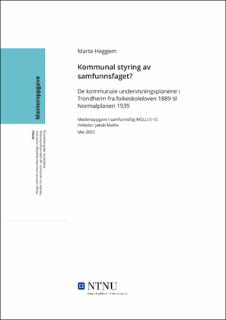| dc.contributor.advisor | Maliks, Jakob | |
| dc.contributor.author | Heggem, Marte | |
| dc.date.accessioned | 2022-07-29T17:19:56Z | |
| dc.date.available | 2022-07-29T17:19:56Z | |
| dc.date.issued | 2022 | |
| dc.identifier | no.ntnu:inspera:110859567:30228597 | |
| dc.identifier.uri | https://hdl.handle.net/11250/3009241 | |
| dc.description.abstract | Formålet med denne masteroppgaven var å undersøke den kommunale styringen av samfunnsfaget i Trondheim kommune i tidsperioden fra folkeskoleloven i 1889 til Normalplanen i 1939. Dette på bakgrunn av at kommunene hadde et lokalt selvstyre over skolen i denne perioden, gjennom blant annet utarbeidelse av undervisningsplaner. For å se på den kommunale styringen av samfunnsfaget i perioden, har jeg sett på utviklingslinjene av faget i Trondheim. Samtidig som jeg også har sett på i hvilken grad undervisningsplanene i Trondheim skiller seg fra de statlige normalplanene.
Kildematerialet som er brukt i denne oppgaven er undervisningsplanene laget av Trondheim kommune i perioden oppgaven tar for seg. I tillegg brukes også de statlige normalplanene for byene fra samme periode. Den teoretiske tilknytningen til denne oppgaven er Goodlads fem virkeligheter av læreplanforståelse. På bakgrunn av kildematerialet, er det hovedsakelig den formelle læreplanen som er hovedtyngden i denne oppgaven, mens den oppfattede og ideologiske også kommer frem. Oppgaven har en historisk forankring basert på kildematerialet og dens kontekst. For å analysere undervisningsplanene og normalplanene har det vært naturlig å gjennomføre en dokumentanalyse, samtidig som det har vært hensiktsmessig å bruke en komparativ metode for å undersøke i hvilken grad Trondheimsplanene skiller seg fra de statlige normalplanene.
Studien viser at de mest fremtredende utviklingslinjene i samfunnsfaget i Trondheim i perioden er det gradvis økende fokuset på det kulturhistoriske, hvor innholdet knyttet til enkeltpersoner og hendelser blir redusert. I tillegg blir antikrigs-budskapet gradvis større og større fra etter første verdenskrig og utover. Når det kommer til i hvilken grad de kommunale planene skiller seg fra normalplanene, er det som i stor grad skiller undervisningsplanen i Trondheim fra de statlige normalplanene likestillingen mellom kjønnene med tanke på timeantallet. Normalplanene har en ulik timefordeling mellom gutter og jenter, mens planene i Trondheim har samme timeantall for begge kjønn. Noe som også skiller planen i Trondheim i 1937 fra Normalplanen i 1925 er samtidens tanker, som i senere tid har fått betydning for nye normalplaner. Utenom dette skiller de kommunale og statlige planene seg i liten grad fra hverandre. | |
| dc.description.abstract | The purpose of this master’s thesis is to investigate the municipal management of the school subject social studies in Trondheim municipality in the period from the Folkeskoleloven in 1889 to The National Curriculum in 1939. This is because the municipalities had significant local autonomy over the school subjects during this period, through a municipal curriculum. To look at the municipal management of the social studies in the period, I have analyzed the development lines of the subject in Trondheim. I have done a systematic comparison of similarities and differences between the municipal curricula in Trondheim and non-obligatory state curriculum.
The source material used in this thesis is the teaching plans made by Trondheim municipality in the period the thesis deals with. In addition, the state’s non-obligatory National Curriculum for the cities from the same period is also used. The theoretical connection to this thesis is Goodlad’s five realities of curriculum understanding. Based on the source materials used, the main emphasis has been on the formal, and to a certain degree ideological and perceived, reality. The thesis has a historical basis based on the source material and its context. To analyze the curricula and the National Curriculum, it has been natural to do a document analysis. It has also been appropriate to use a comparative method to be able to examine the extent to which the Trondheim plans differ from the state plans.
The study shows that the most prominent lines of development in the social studies’ subjects in Trondheim in this period are the gradually increasing focus on the cultural history. The content related to particularly important historical individuals and events is reduced. In addition, the anti-war message was gradually getting more prominent from after the First World War and onwards. The teaching plan in Trondheim differs from the state’s National Curriculum in large extent when it comes to equality between the genders in terms of the number of hours. The National Curriculum has a different distribution of hours between boys and girls, while the plans in Trondheim have the same number of hours for both sexes. Something that also separates the plan in Trondheim in 1937 from the normal plan in 1925 is contemporary ideas, which in recent times have become important for new normal plans. Apart from these findings, the municipal and state plans do not differ much from each other. | |
| dc.language | nob | |
| dc.publisher | NTNU | |
| dc.title | Kommunal styring av samfunnsfaget? De kommunale undervisningsplanene i Trondheim fra folkeskoleloven 1889 til Normalplanen 1939 | |
| dc.type | Master thesis | |
